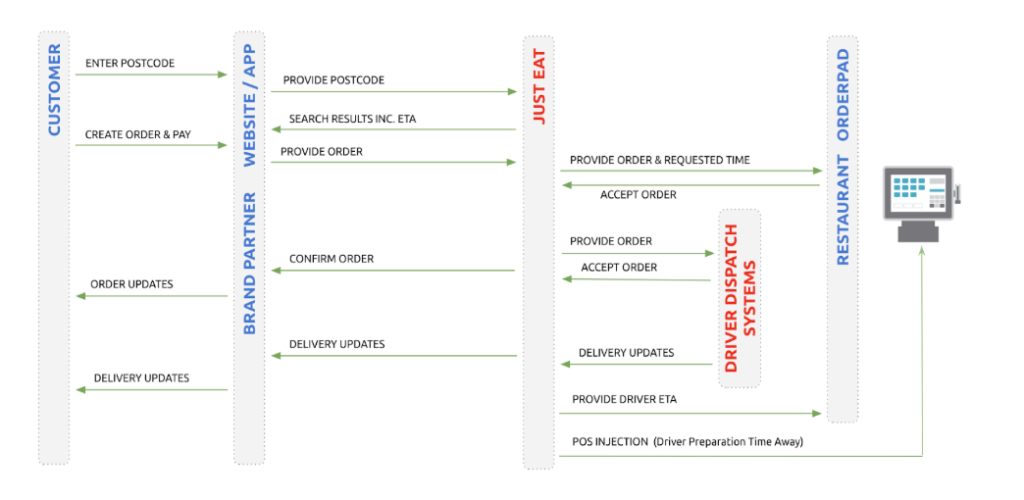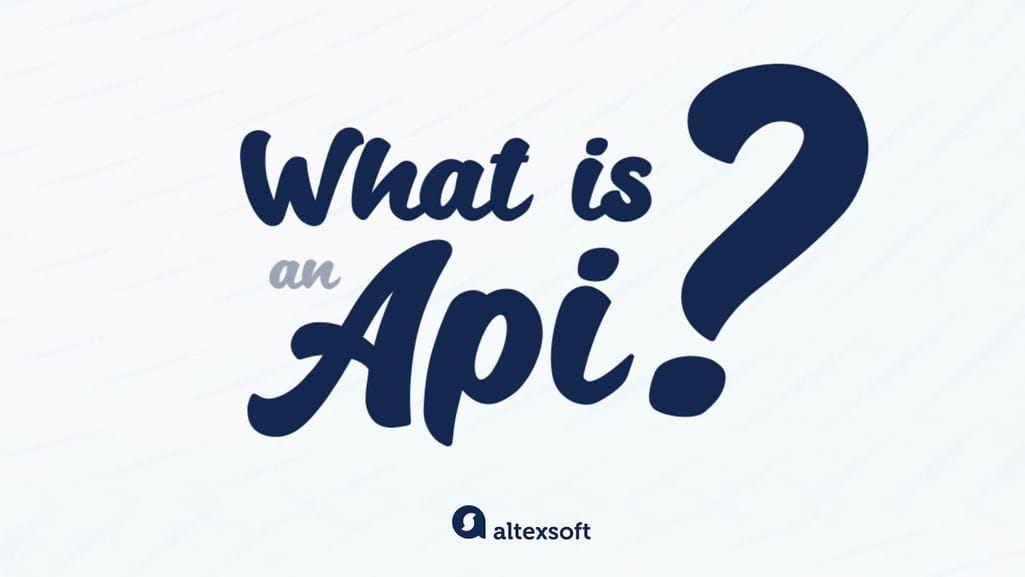

How applications talk to each other
In this article, we’ll describe the main API providers in the restaurant industry. We’ll talk about key players in the restaurant technology market who offer software solutions to restaurateurs as well as integrate table bookings and provide restaurant data for travel and hospitality businesses.
Key dining experience platforms interconnection: restaurant reservation systems, POS, booking aggregators, etc.
To build a complex system that helps discover, explore, book, and order at restaurants, here are various sources to be connected via APIs.
Table reservation systems (TRSs). This restaurant management software makes the jobs of restaurateurs, administrators, and waiters easier by consolidating all table and guest-related activities into one user-friendly dashboard. Basic functions include
- gathering bookings from phone, email, and aggregators,
- table seating options with custom plans,
- connected mobile apps for enterprise mobility,
- guest surveys,
- discounts for regular clients, and more.
Booking aggregators. Sites like OpenTable and Yelp, which we’ll talk about later, connect with TRSs via APIs to retrieve info about tables and provide diners with an opportunity to make reservations. These platforms also use review websites’ APIs to collect comments, photos, and tips for a restaurant posted there, or integrate with Google Maps to provide location details and transportation options.
Point of sale systems. Combining software and hardware, these transaction management systems allow customers to pay via terminals, touch screens, and other options. Modern POS systems for restaurants combine functionality for inventory management, labor management, reporting, and loyalty programs. POS software connects with aggregators via APIs so that the restaurant staff is informed about the food ordered and the payment made.
External dining-related platforms. In this article, we identify the following elements of the dining experience:
- location discovery,
- ordering and delivery,
- menu standardization and sharing, and
- restaurant rating.
These websites, apps, and services provide their own information useful for guests and other industry players: Review and menu platforms send their data via APIs to reservation websites, delivery apps are integrated with POS systems to enable remote ordering, etc.
The more sources are interconnected via APIs, the more data can be provided to end-users in a single environment.
Global restaurant reservation software providers and APIs
As such a big connectivity hub between visitors and restaurateurs, reservation platforms are more than just websites – they’re software providers often offering table reservation systems, APIs, widgets, or white label solutions for a restaurant’s online presence. Their main target is to help put more diners in seats, so they use complex, sophisticated approaches, including machine learning, to optimize every moment of service.
Let’s examine the three leading restaurant reservation systems: OpenTable, Yelp Reservations, and ResyOS – and the APIs they provide.
OpenTable
An undisputed leader in online restaurant booking, OpenTable owns over 21 percent of the entire reservation software market. Operating since 1998, the platform is a familiar presence in the restaurant scene. Restaurateurs and visitors alike agree that OpenTable has a very user-friendly interface and convenient booking flow.
Table management system. Among OpenTable’s pros is a simple-to-use table management system with guest recognition and email marketing features, as well as takeout management, reporting, suite of integrations, and so on. The platform helps fill empty tables and contributes to steady business flow by drawing attention to tables that are open on the consumer app.
Depending on the plan, pricing for their software products ranges from $49 to $449 per month plus a cover fee.
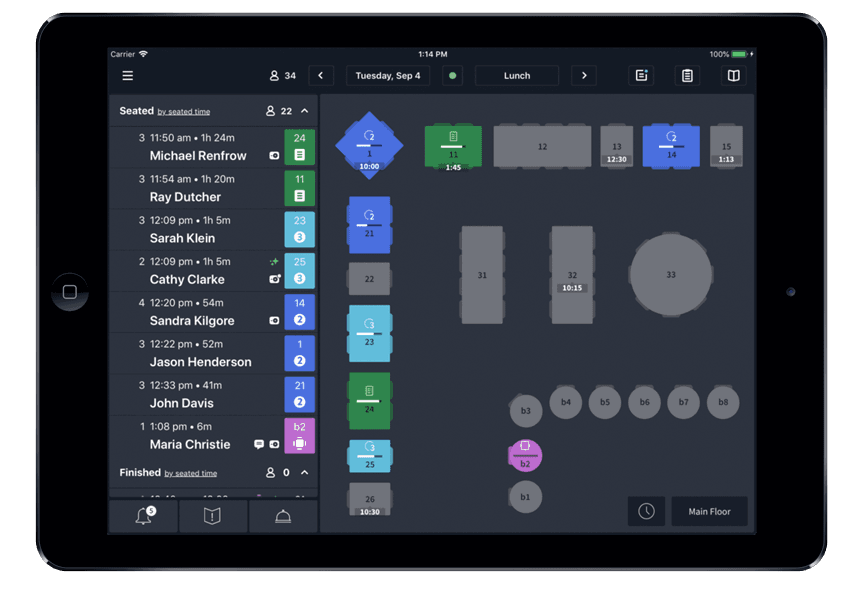 Table management dashboard on OpenTable
Table management dashboard on OpenTable
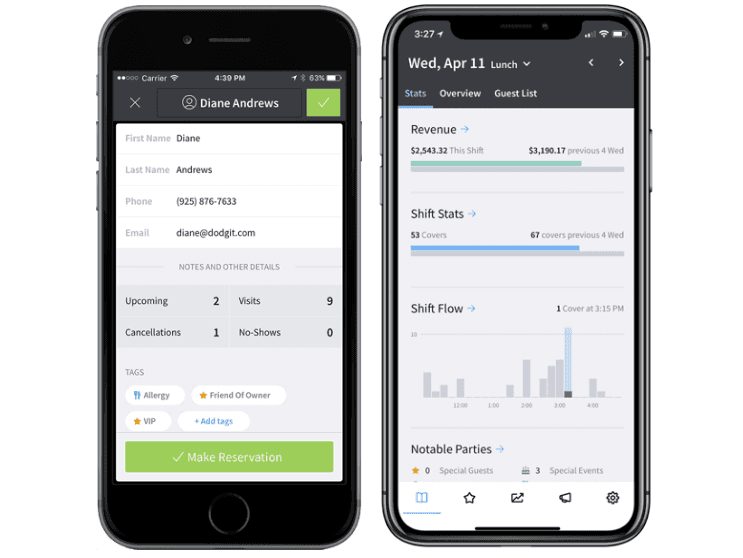
OpenTable owner app interface
APIs. The OpenTable APIs allow partners to retrieve such content as the restaurant’s name, address, longitude/latitude, and phone number, plus a reservation link. However, OpenTable doesn’t offer an open API, so if you want to enjoy its benefits, apply for the affiliate program. Since not every applicant gets approved, there’s another option – the unofficial API for accessing OpenTable restaurant data and URLs where reservations can be made. Additionally, you can use a widget to add the OpenTable reservation form to your website.
Yelp Reservations
Yelp boasts 95 million active users a month. These people heavily rely on its ratings, reviews, and accurate data to make decisions. And finding a place to eat is one of them. That’s why many businesses want to be listed on the website and also integrate its extensive database of reviews into their products.
Table management system. Yelp’s Guest Manager is already interconnected with its online booking platform to seamlessly manage reservations from there. Among other features are SMS communication with clients, waitlist management, and a Guestbook to leave suggestions and preferences of returning diners.
Pricing starts at $249 per month with no cover fees.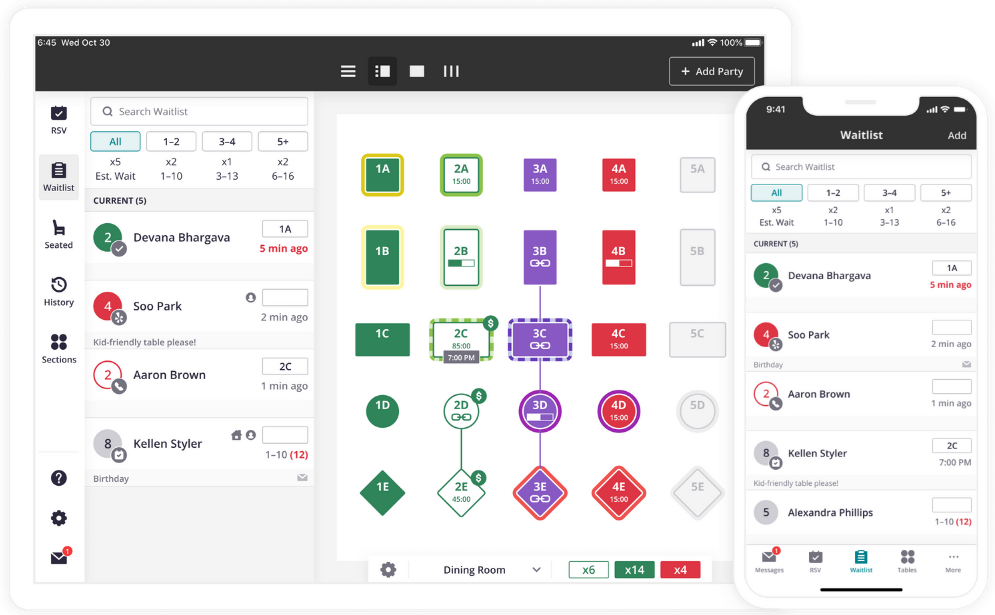
Yelp’s table and waitlist management solutions
APIs. Yelp’s API offerings are very rich, providing integration options for different purposes. Businesses can integrate their transaction services through Yelp Platform and its three components: Data Ingestion API, Transaction Iframe, and Yelp Checkout API. You can also take advantage of Yelp Knowledge to get data and support your business analytics activities.
To search and retrieve Yelp’s content (business listings, reviews, etc.) in third-party apps, check Yelp Fusion APIs (we’ll talk more about them later on).
Resy OS
Initially started as premium reservations, now the Resy platform connects 9,000 network restaurants globally and covers 160 cities.
Table management system. Resy OS offers a floor plan with table and customer management that synchronizes with a booking widget at the restaurant’s site. Resy’s built-in, two-way texting with guests enables direct relationships between consumers and restaurants. The platform tracks small but important events like wine ordering and table greetings.
Resy allows restaurants to allocate reservations to different subsets of their customer base. This way, to maximize profit, restaurants can offer more reservations to guests who come through a certain channel, if they appear to be the biggest spenders. The platform also allows diners to prepay for the meal and provides an array of reporting options.
There are three pricing plans of $249, $399, and $899 a month depending on the features and integrations.
APIs. The Resy API displays available reservations depending on search criteria, providing a list of all user reservations, offering details on any chosen venue, and integrating the list of top venues picked by the Resy team. The API returns the information on restaurant location, number of free seats, price ranges, platform-specific tags (such as “Yummy food!” or “Vegan Joint”), ratings from Foursquare and Google, and contact info. The API access is included in the Full-Stack pricing plan designed for enterprises.
Adding on to restaurant reservation systems
Other reservation systems, although global and convenient to use as well, don’t provide APIs for integration. Meanwhile, they can be of use to the restaurants that need reservation platforms for online booking or want to attract new customers to their business while being posted on a popular restaurant aggregator website.
TheFork (formerly BookaTable). While OpenTable rules the US market, TheFork is the European leader in online restaurant reservations with 12.7 percent market share. TheFork Manager software streamlines the reservation process and helps with customer management.
Eveve. Established in the UK, Eveve, now operating globally, is popular in the US, New Zealand, Canada, South America, and so on. Eveve’s table management system Telos helps handle online reservations, telephone bookings, and walk-ins on the same system. Its special feature is an auto-constructed customer database made from day-to-day reservation activities, giving owners insights into their respective demographics. Also, Eveve offers a proprietary, fully-integrated electronic point of sale (EPOS) system.
Quandoo. German-based Quandoo is present in 12 countries across Europe and Asia. Its tech solutions for restaurants include a reservation management system, as well as table management, marketing, and reporting tools. It boasts pre-established integrations with such major partners as Google and Instagram, which can be appealing for businesses that want to expand their customer reach.
Location discovery and restaurant rating APIs
When looking for a place to chow down, two things can make choosing easier – location and rating. Using APIs, you can now build location-aware applications complemented by user reviews with minimal effort. If you run a travel or rental platform, such data can be a perfect complement to your website or mobile app, offering your visitors dining suggestions in selected areas.
The key location and rating players include such well-known names as Google Places, Foursquare, Yelp, TripAdvisor, and Zomato with its Foodie Index.
Google Places API
Before Google Places existed, location services for mobile apps used to rely only on longitude and latitude. Now tapping into a set of basic coordinates, Places API:
- searches restaurants in over 100 different categories,
- provides detailed info along with reviews and photos from the Google Places database, and
- returns suggested queries.
The API can be used for implementing a feature that allows users to find restaurants located around them via GPS. For that purpose, you’ll need to set a specific category search – restaurants – using the request object as shown in the code below.
Type filtration in the Places API, Source: ImranNaqvi on StackOverflow
Foursquare API
Foursquare Places API is another service for searching nearby locations. It can power location-based experiences in your app or website by:
- enabling location search and sharing,
- providing details about a restaurant,
- giving access to a number of place attributes, and
- retrieving photos, tips, and reviews posted on Foursquare by customers.
To get started, you’ll need to create a developer account on Foursquare.
In addition to the API, Foursquare offers the following products.
Pilgrim software development kit is a location-awareness engine that provides users with contextually-relevant, geo-aware content.
Places Database provides recognition of 105 million global places categorized and graded with the innovative ten-point rating scale and popularity scores. It’s done via Snap-to-Place technology that connects a physical location with meaningful venues.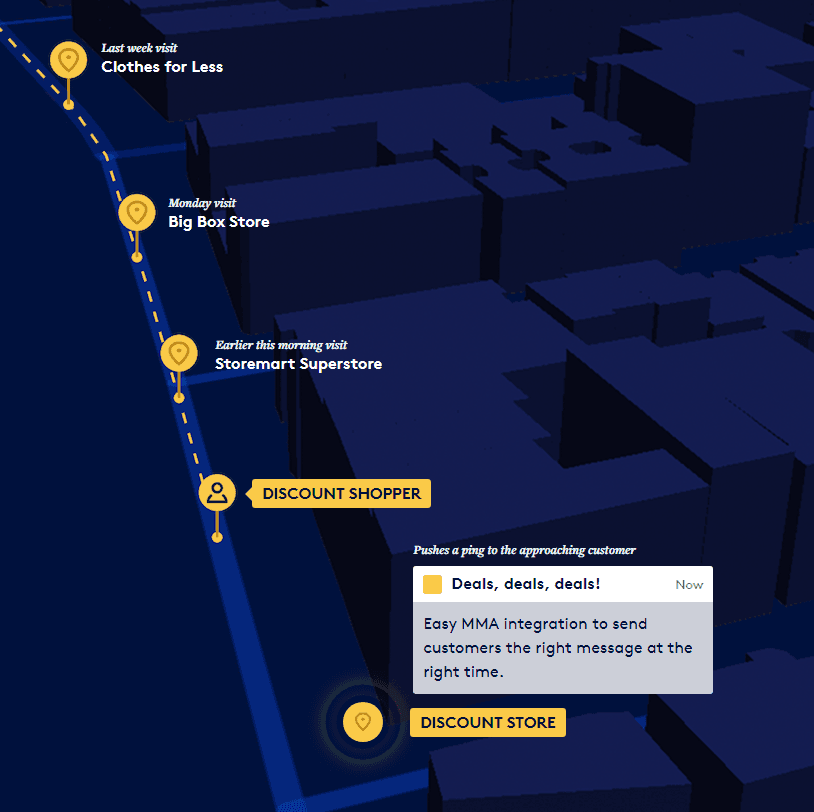
An example of a customer profile using Pilgrim SDK integrated with a mobile marketing automation system
Yelp Fusion API
Yelp Fusion API that we mentioned above is a powerful and easy-to-use tool that allows you to get the best local content and user reviews from 32 countries. Its features include:
- search by keyword, main business attributes (location, category, open hours, price level, phone number), and delivery support;
- autocomplete suggestions; and
- retrieval of detailed restaurant content, i.e. photos, price levels, hours of operation, and Yelp rating (Yelp sorts reviews by recency, votes, users you follow, and other review quality factors).
An example of how Yelp API integration can broaden a platform’s abilities is Trulia, a real estate website. Its maps can show consumers the cafes, coffee shops, or pubs in a neighborhood, which can factor into the home search process.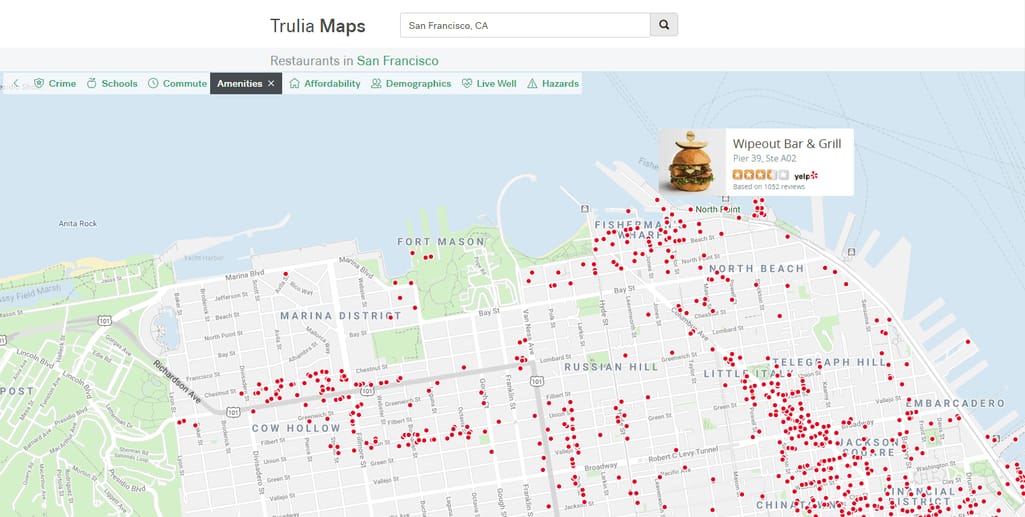
Trulia map with restaurants info using the Yelp API
Sometimes clearly defined endpoints of the regular API don’t match your needs. In this case, you can make modifications to them using Yelp’s GraphQL API. This API query language enables the customizing of requests to fit specific use cases. Then, if your use case doesn’t require all of the data, GraphQL speeds up your requests by doing less work on the server side to fulfill them. However, while still in beta, GraphQL is limited to 10,000 queries per day.
TripAdvisor Content API
Restaurants are one of the three major place-of-interest (POI) types on TripAdvisor, within which three subcategories are defined: sit down, bakery, and fast food.
Besides name and address, the TripAdvisor Content API provides access to the following restaurant details:
- overall bubble rating – a summary of your ratings and reviews using the 1 (terrible) to 5 (excellent) rating scale;
- subratings measured against a number of subcategories: food, service, value, and atmosphere;
- popularity ranking – a popularity index ranking on TripAdvisor, which compares restaurants within the same destination based on their popularity. It’s measured by the quality, quantity, and recency of their review content on TripAdvisor;
- the number of reviews the rating is based on;
- awards: Travelers’ Choice and Certificate of Excellence;
- the number of traveler photos for this restaurant published on TripAdvisor;
- a localized relative price level; and
- restaurant cuisine type.
To get access to the TripAdvisor API, provide your credentials and remember about the limits: 10,000 daily API calls and up to 50 calls per second. The price is $89 per month. Also note that the number of API keys is limited, and not granted for data analysis, academic research, or any use not associated with a consumer-facing (B2C) travel website or application.
Ordering and Delivery APIs
If you decide to facilitate the delivery experience, you’ll have to integrate ordering and delivery functions into your product. Some delivery service providers have APIs for restaurants or POS systems, while others offer connectivity with third-party apps. Let’s see what’s out there.
Uber Eats
Uber Eats is one of those industry behemoths that don’t need any introduction. Foodies in 45 countries worldwide are familiar with the service, ordering food delivery online or through a mobile app.
Uber created Eats APIs to allow partner restaurants to
- manage their business information (address, availability, holiday hours),
- synchronize menus,
- receive orders, and even
- request reporting.
To get access to APIs, you’ll have to fill in and submit the partner agreement and contact your Uber Eats partner manager.
Just Eat Takeaway
Just Eat is an online ordering service that was founded in Denmark in 2001 and merged with another delivery company – Takeaway.com – in 2020 to become one of the industry leaders operating in 23 countries. In 2021, the company acquired one more well-known player – GrubHub.
Just Eat Developer platform currently offers 3 sets of APIs:
- Delivery Partners – for logistics companies that want to provide courier services;
- POS Partners – to integrate with restaurant POS systems and streamline the food ordering process; and
- White Label Partners – to integrate the food ordering capability and delivery experience into third-party applications.
Just Eat’s White Label “Delivery as a Service” Flow
DoorDash
Bloomberg Second Measure calculated that DoorDash accounted for 59 percent of U.S. consumers’ meal delivery sales in April 2022. As of today, DoorDash operates in the US, Canada, Australia, Japan, and Germany, and besides restaurant delivery, it’s the largest player in the convenience store delivery market.
DoorDash has a user-friendly Developer Portal with detailed documentation for two API categories.
DoorDash Drive suite helps request deliveries from third-party apps, providing access to a fleet of local drivers (Dashers). Note that now, during the beta period, the standard DoorDash Drive APIs are for deliveries within the US only, so if your business is in Canada or Australia, you’ll need Drive (classic) APIs. If you have any difficulties, contact their support team.
DoorDash Marketplace is for partners that want to connect their POS systems to DoorDash service and be able to receive orders from the platform. Restaurateurs can use these APIs to create and manage their company details, update menus, and receive orders – all within their system.
Deliveroo
British food delivery company Deliveroo operates in 12 markets: 8 in Europe, 3 in Asia, and Australia. Based on predictive technology, Deliveroo evaluates the most efficient way of distributing orders depending on the location of restaurants, riders, and customers. Using machine learning, they predict the time it will take to prepare a meal.
Their Restaurant Partner API lets the user view Deliveroo food orders live in one place, instead of having to manually input them into the restaurant’s sales system:
- sync status showing whether or not the order was successfully sent to the restaurant’s POS (succeeded or failed);
- prep stage describing how order preparation is going: in kitchen, ready for collection, or collected; and
- order details can report all orders on a certain date / at a certain time.
So far, around 500 restaurants sites along with 25 POS companies have plugged into the API. Deliveroo claims that the API integration takes about two weeks.
APIs for menu standardization and sharing
Since the first point of contact for many potential customers happens online, restaurant menus have to be up to date all the time. By means of the APIs described in this section, restaurants can make changes to multiple places and update their menus across the web in one easy step. As a result, your platform always fills the bill for visitors with relevant info.
OpenMenu
OpenMenu is an online platform that stores restaurant menus in a freely accessible and searchable database (over 500K menus and over 25 million menu items). For restaurants, it’s a convenient way to create, manage, and promote their online presence.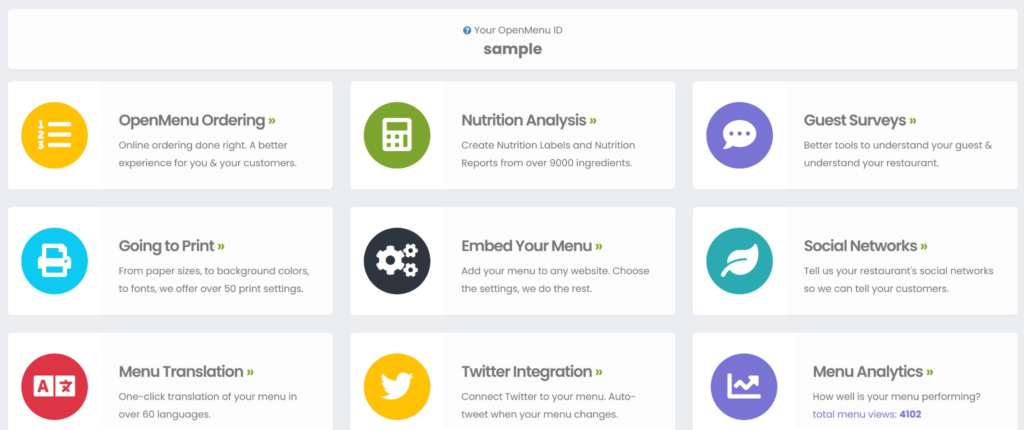
OpenMenu platform
OpenMenu APIs come in 2 groups. Standard APIs offer to embed search capabilities into your platform and help with finding:
- restaurants in a specific location;
- deals, coupons, or daily specials for a restaurant, and
- ingredients and nutrients.
Enterprise API, beside search capabilities, grants access to ML-powered analytics, allowing users to monitor market trends, scrutinize menus, conduct gap analysis, and more.
Which API to connect to?
Integrating with an API can be a great commitment depending on the scope of the system. It can involve large investments of both time and money. Although we’ve covered a few different areas, you may still be left with a question, Which API is the best for my circumstances?
The simple answer is – it depends on your business requirements, current resources, and development plans. Here are a few tips for you that might help with the decision.
Geography. Make sure that the data you connect to is relevant for your target area. Otherwise, you won’t find it useful. So, let’s say it’s a location discovery API. Check whether it finds your whereabouts. If it’s an order and delivery API, be sure it works for restaurants in your part of the world.
Functionality. Does this API do everything you need? Filter your selection based on the availability of features that are must-haves for you.
Request limits. We must know how to administer the API in such a way that we do not exceed its limit. Otherwise, the system could expel you. Some companies limit calls in the middle of a very important action, due to its hosting performance limitations. In contrast, a good practice is to provide info on the number of calls left each time a call is made. This way, it’s much easier to create an efficient and reliable service using an API.
Support and an active community. If things go wrong, you’ll need someone to address your questions to. So, it’s a big plus when the API providers offer reliable customer support and have an active community. Additionally, it’s better if the company actually uses the API itself in its own products. If they do, it’s more likely to be well supported and have lots of options.
Secured authentication. Choose the API that allows for access only if it can authenticate from your end, rather than something open to everyone else.
Business logic. An API whose names and methods conform to the conventions used in your platform will result in a smoother and more successful integration.
API provider’s reputation. Remember that your name will appear among the API's customers. Consequently, its reputation may have either a positive or negative effect on your business's image.
Interested in travel APIs? Check our other pieces on the topic:
Main travel and booking APIs
Flight and air booking APIs
Airport transfers APIs and solutions
NDC connections and APIs
Low-cost booking APIs
Hotel APIs
Car rental APIs
Tours and attractions APIs
Channel management in hotels APIs
Custom channel management in hotels APIs
Public transportation APIs


